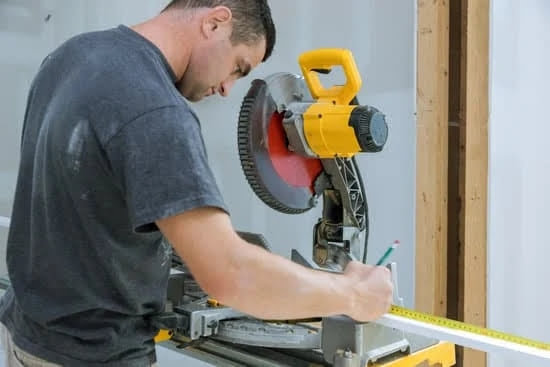In the world of woodworking, few things can be as frustrating and disruptive as a woodworking router shutting off randomly during use. Whether you are a seasoned woodworker or just starting out, experiencing this issue can not only hinder your progress but also leave you puzzled as to why it is happening in the first place. Understanding the reasons behind this problem is crucial for both troubleshooting and preventing future shutdowns.
This article aims to delve into the various factors that can cause a woodworking router to shut off unexpectedly and explore the potential technical malfunctions behind these shutdowns. From overheating issues to power supply problems, faulty wiring, and even router bit issues or software glitches, we will examine each potential cause in detail.
By gaining a deeper understanding of why a woodworking router shuts off randomly, you will be equipped with the knowledge needed to identify and resolve this frustrating issue. Additionally, we will provide expert tips and troubleshooting advice on how to effectively address these problems and maintain a reliable woodworking router. So let’s dive in and unravel the mystery behind random router shutdowns.
Common Causes
A woodworking router is a versatile and essential tool in any woodworker’s arsenal. However, it can be extremely frustrating when your router shuts off randomly during use. Understanding the potential technical malfunctions that can cause this issue is crucial in resolving the problem and ensuring smooth and uninterrupted operation.
One common cause of random router shutdowns is overheating. When a router operates for extended periods without adequate cooling, the motor can become overheated, leading to automatic shutdowns as a protective measure. High temperatures can cause damage to internal components and reduce the overall lifespan of the tool. It is important to ensure proper ventilation and airflow around the router during use, especially when working on large or demanding projects.
Power supply problems are another possible culprit behind random shutdowns. Electrical interruptions or voltage fluctuations can disrupt the power flowing into the router, causing it to shut off unexpectedly. This can occur due to issues with the circuit breaker or wiring in your workshop, as well as external factors like power surges or outages. Checking the circuitry and using surge protectors or uninterruptible power supplies (UPS) can help stabilize the power supply to your woodworking router.
Faulty wiring is yet another factor that can contribute to random shutdowns. Loose connections, damaged cords, or improper grounding can all lead to electrical disruptions and cause the router to shut off abruptly. Inspecting your router’s wiring regularly for signs of wear and tear, securing loose connections, and using high-quality extension cords are important steps in preventing these issues from occurring.
Overheating Issues
One common cause of a woodworking router shutting off randomly is overheating. As routers operate, they generate heat, and if not properly managed, this can lead to a shutdown. Overheating can occur when the router is being used for extended periods without breaks or when it is being used in high-temperature environments.
When a router overheats, it can trigger a thermal overload protection feature that automatically shuts off the tool to prevent damage. This feature is designed to protect the motor and internal components from excessive heat. However, frequent random shutdowns due to overheating can be frustrating and interrupt workflow.
To address overheating issues, it is important to ensure proper ventilation for the router. Most routers come with cooling fans or vents that allow air circulation around the motor and other critical parts. It is essential to keep these areas clean and free from any obstructions that might impede airflow.
Another way to prevent overheating is by giving the router periodic breaks during extended use. This allows the tool’s temperature to stabilize and prevents it from reaching critical levels. Additionally, using the tool in a cool environment or providing additional cooling measures such as fans or cooling pads can help maintain optimal operating temperatures.
Regular maintenance also plays a crucial role in preventing overheating issues. Cleaning dust buildup inside the router and ensuring that all components are securely fastened will promote better heat dissipation. Furthermore, checking for any signs of wear or damage on brushes or bearings and replacing them as needed will help keep the router running smoothly and reduce the risk of overheating.
By understanding and addressing issues related to overheating, woodworkers can minimize random shutdowns caused by this particular technical malfunction. Implementing preventive measures such as maintaining proper ventilation, taking breaks during extended use, using additional cooling methods when necessary, and performing regular maintenance tasks will help ensure that their woodworking routers perform reliably and efficiently.
Power Supply Problems
Power supply problems can often be a cause for a woodworking router shutting off randomly. Electrical interruptions and voltage fluctuations can have a significant impact on the performance and stability of the router. Understanding these issues can help in diagnosing and resolving the problem.
Electrical interruptions occur when there is a sudden loss of power or a break in the electrical circuit. This can happen due to various reasons such as tripped circuit breakers, loose connections, or faulty wiring. When an interruption occurs, it can cause the router to shut off immediately. In some cases, the power may come back on after a few seconds, causing the router to restart. These intermittent shutdowns can be frustrating and disruptive to the workflow.
Voltage fluctuations are another common problem that can lead to random shutdowns. Fluctuations in voltage levels can occur due to unstable power sources or issues within the electrical system of the workshop. High voltage levels can overload the router’s circuitry, causing it to shut off as a safety measure. On the other hand, low voltage levels may not provide enough power for proper operation and result in unexpected shutdowns.
To address power supply problems, it is important to ensure that the woodworking router is plugged into a stable and reliable power source. Checking for loose connections or faulty wiring is also essential in preventing electrical interruptions. Additionally, using surge protectors or voltage stabilizers can help mitigate the impact of voltage fluctuations on the router’s performance.
| Issue | Possible Causes | Solution |
|---|---|---|
| Electrical Interruptions | Tripped circuit breakers, loose connections, faulty wiring | Check circuit breakers, inspect connections, repair faulty wiring |
| Voltage Fluctuations | Unstable power sources, electrical system issues | Use surge protectors or voltage stabilizers |
By addressing power supply problems and ensuring a stable electrical environment, woodworkers can minimize the chances of random shutdowns and maintain a reliable woodworking router.
Faulty Wiring
Faulty Connections Leading to Random Shutdowns
One of the potential reasons for a woodworking router shutting off randomly is faulty connections within the machine. Over time, vibrations and movement can cause wires to become loose or disconnected, resulting in an intermittent or complete loss of power. This issue can be particularly frustrating as it may seem unpredictable and difficult to diagnose.
To determine if faulty wiring is the culprit behind the random shutdowns, it is important to thoroughly inspect all electrical connections within the router. Start by checking the power cord and ensuring that it is securely plugged into a reliable power source. If there are any signs of frayed or damaged wiring, it is crucial to replace the cord immediately.
Additionally, examining the internal wiring connections within the router itself is necessary. Loose or poorly connected wires can result in a sporadic loss of power, leading to random shutdowns. Carefully inspect each connection point and secure any loose wires using appropriate tools or consulting a professional if needed.
Loose Cords and Their Impact on Router Performance
In some cases, random shutdowns may also be caused by loose cords connected to the woodworking router. These cords include both the power cord from the wall outlet and any auxiliary cables used for specific functions such as dust collection systems or lighting attachments.
During operation, excessive vibration or movement can cause these cords to become dislodged or loosely connected. As a result, intermittent power interruptions occur, leading to random shutdowns of the router.
To address this issue, users should regularly check all cords attached to their woodworking routers. Ensure that they are securely seated in their respective ports and tightened properly if necessary. It may also be beneficial to use cable management solutions such as cable clips or ties to keep cords organized and prevent them from being accidentally tugged or pulled during use.
Preventing Random Shutdowns with Proper Wiring Maintenance
Proactive maintenance and regular inspections are key to preventing random shutdowns caused by faulty wiring in a woodworking router. Implementing the following practices can help maintain reliable connections and reduce the risk of sudden power loss:
- Regularly inspect all cords and wires for signs of damage or wear. Replace any frayed or damaged cords immediately.
- Securely plug the power cord into a stable electrical outlet and ensure a snug fit.
- Check internal wiring connections within the router, tightening any loose wires as needed.
- Use cable management solutions to keep cords organized and prevent accidental tugging or loosening during operation.
- Follow manufacturer guidelines for maintenance and cleaning, as these can also help identify and prevent potential wiring issues before they lead to random shutdowns.
By prioritizing proper wiring maintenance, woodworkers can significantly reduce the frustrating occurrence of random router shutdowns, ensuring smooth operation and optimal performance.
Router Bit Issues
One of the common causes for a woodworking router shutting off randomly is issues with the router bit. This section will focus on analyzing the impact of dull blades, improper bit installation, and bit defects on router shutdowns.
Dull blades can significantly affect the performance of a woodworking router. When a blade becomes dull, it requires more power to cut through the wood, putting extra strain on the motor. This increased strain can cause the router to overheat and shut off unexpectedly. To prevent this issue, it is important to regularly check and replace dull blades with sharp ones.
Improper bit installation is another potential cause for random shutdowns. If the router bit is not securely installed or if it is not properly aligned with the collet, it can cause vibrations or wobbling during operation. These vibrations can lead to errors in cutting and potentially trigger protective mechanisms that shut off the router. Ensuring that the bits are properly installed and tightened can help minimize this problem.
Bit defects can also be a source of random shutdowns. If a router bit has manufacturing defects or damages such as cracks or chips, it may not function properly during operation. These defects can increase friction and heat, leading to motor overheating and unexpected shutdowns. Regularly inspecting router bits for any signs of defectiveness and replacing them when necessary is crucial in preventing random shutdowns.
To summarize, router bit issues such as dull blades, improper installation, and defects can have a significant impact on woodworking routers shutting off randomly. Regularly maintaining sharp blades, ensuring proper installation of bits, and inspecting them for defects are essential steps in preventing these issues from occurring. By addressing these specific issues related to router bits, woodworkers can maintain a reliable woodworking router that operates smoothly without unexpected shutdowns.
Software and Firmware Glitches
In today’s modern woodworking industry, technology plays a significant role in enhancing efficiency and precision. However, with the integration of digital settings and firmware updates, there can also be potential drawbacks. This section will delve into how software and firmware glitches can disrupt router operation.
One common issue related to software glitches is the presence of bugs or errors in the programming code. These bugs can cause the router to shut off randomly or malfunction in unexpected ways. Additionally, software updates may introduce compatibility issues with other components or modules within the system, leading to disruptions in router operation.
Firmware, on the other hand, refers to the embedded software that controls and manages hardware functionalities on a device such as a woodworking router. When firmware becomes outdated or corrupted, it can result in erratic behavior or complete shutdowns of the router. Furthermore, firmware updates gone wrong or incomplete installations can introduce new glitches that affect overall performance.
To mitigate these software and firmware glitches, woodworking professionals should regularly update their routers’ software to the latest stable versions provided by manufacturers. It is crucial to check for any reported issues related to new updates before installing them to avoid potential disruptions. Furthermore, it is advisable to have backups of previous firmware versions readily available in case a rollback becomes necessary.
| Issue | Possible Solution |
|---|---|
| Bugs or errors in programming code | Regularly update router software; check for reported issues before installing updates |
| Compatibility issues with components | Select compatible components; consult manufacturer guidelines before updating software |
| Outdated or corrupted firmware | Regularly update firmware to latest stable versions; maintain backups of previous versions |
| Incomplete or faulty firmware installations | Ensure proper installation procedures are followed; consult manufacturer support if issues persist |
Safety Measures
Understanding the Importance of Safety Measures
When it comes to preventing random shutdowns of a woodworking router, safety measures play a crucial role. Not only do these protective features ensure the longevity and durability of the router itself, but they also guarantee the safety of the user. In this section, we will delve into some key safety measures that can help prevent random router shutdowns.
Protective Features
One important safety measure is to invest in a woodworking router that comes equipped with protective features. These features are designed to safeguard both the router and the operator during operation. One common protective feature is an overload protection system that automatically shuts off the router when it exceeds its load capacity or reaches a dangerous level of heat. This prevents potential damage to the motor and other internal components.
Another crucial feature is a circuit breaker or thermal switch that trips and disconnects power in case of electrical overloads or short circuits. This helps prevent damage caused by power supply problems such as voltage fluctuations or electrical surges. Additionally, routers with ergonomic designs that include features like non-slip handles and dust collection systems can enhance both operator comfort and safety.
Maintenance Practices
Along with using routers equipped with protective features, regular maintenance practices are essential for preventing random shutdowns. Maintenance involves inspecting, cleaning, and properly maintaining all components of the router. Keeping the router clean from dust and debris not only improves its performance but also reduces the risk of overheating.
Regularly checking and tightening any loose bolts, screws, or connections can prevent interruptions in power supply caused by faulty wiring. Lubricating moving parts such as bearings and bushings ensures smooth operation and reduces wear on critical components. It is also important to regularly inspect router bits for any signs of damage or dullness and replace them promptly to avoid issues related to bit defects.
Taking these maintenance practices seriously not only increases the lifespan of the router but also reduces the chances of random shutdowns. Furthermore, it is crucial to follow the manufacturer’s guidelines and recommendations for maintenance, as each router may have specific requirements.
By incorporating protective features and practicing regular maintenance, woodworkers can significantly reduce the occurrence of random shutdowns in their woodworking routers. These safety measures not only ensure uninterrupted operation but also contribute to a safe working environment. In the next section, we will provide some expert tips and troubleshooting techniques to help identify and resolve any lingering issues with random router shutdowns.
Expert Tips and Troubleshooting
When faced with the frustration of a woodworking router shutting off randomly, it is important to understand the underlying causes and take necessary steps to resolve the issue. Here are some expert tips and troubleshooting techniques that can help you identify and resolve random router shutdowns:
- Check for Overheating: One common cause of random shutdowns is overheating. When the router’s motor gets too hot, it automatically shuts off to protect itself from damage. To prevent overheating, ensure proper ventilation by keeping the router in a well-ventilated area. Additionally, regularly clean the router’s air vents and cooling fans to remove any dust or debris that may obstruct airflow.
- Verify Power Supply: Another potential cause of random router shutdowns is power supply problems. Insufficient power or voltage fluctuations can lead to unexpected shutdowns. Ensure that your router is connected to a stable power source with no visible signs of damage or frayed wires. Consider using surge protectors to safeguard against power fluctuations.
- Check Wiring Connections: Faulty wiring connections can also contribute to random shutdowns. Inspect all the electrical connections between the router, power source, and any additional accessories for loose connections or damaged cords. If necessary, replace faulty wiring or consult a professional electrician for assistance.
- Inspect Router Bits: Dull blades, improper bit installation, or bit defects can impact the performance of your woodworking router and result in unexpected shutdowns. Regularly inspect your router bits for signs of wear or damage. Sharpen or replace dull bits promptly, and ensure proper installation according to the manufacturer’s instructions.
- Update Software/Firmware: In some cases, software or firmware glitches can disrupt router operation leading to random shutdowns. Check for any available updates from your router manufacturer and install them accordingly following their instructions.
By following these expert tips and troubleshooting techniques, you can identify the potential causes of random router shutdowns and take appropriate action to resolve them. Remember, regular maintenance and adherence to safety measures are crucial in ensuring the reliable and efficient performance of your woodworking router.
Conclusion
In conclusion, understanding the frustration of a woodworking router shutting off randomly is crucial for any woodworker. Through exploring the common causes behind router shutdowns, such as overheating issues, power supply problems, faulty wiring, router bit issues, and software and firmware glitches, woodworkers can gain valuable insights into troubleshooting and resolving these issues.
One of the major factors contributing to random router shutdowns is overheating. High temperatures can significantly impact the performance of the router and cause it to shut off unexpectedly. It is important for woodworkers to ensure proper ventilation and cooling mechanisms are in place to prevent overheating.
Power supply problems can also lead to random shutdowns. Electrical interruptions and voltage fluctuations can disrupt the smooth operation of a woodworking router. It is recommended to use a stable power supply and consider investing in surge protectors or voltage stabilizers.
Faulty wiring can be another culprit behind random shutdowns. Carefully examining the connections and ensuring that all cords are secure can help prevent unexpected stoppages. Regular maintenance practices should also include checking for loose or damaged wires.
Router bit issues, including dull blades, improper bit installation, or bit defects, can also cause random shutdowns. Ensuring that router bits are properly sharpened and installed correctly will contribute to a more reliable performance.
Lastly, software and firmware glitches can disrupt router operation. Updating digital settings or firmware may introduce bugs or compatibility issues that result in shutdowns. Woodworkers should take caution when implementing updates and consult manufacturer guidelines if necessary.
To maintain a reliable woodworking router, it is vital to prioritize safety measures such as using protective features like circuit breakers or thermal shutoff switches. Additionally, regular maintenance practices should be followed including cleaning dust buildups around vents or fans and lubricating moving parts as recommended by the manufacturer.
Frequently Asked Questions
What are the disadvantages of a router woodworking?
One of the disadvantages of using a router in woodworking is that it requires a certain level of skill and knowledge to operate effectively. Routers can be quite powerful tools, which means they can cause serious injury if not used properly.
Additionally, routers have sharp spinning bits that need to be replaced periodically, and this can become quite expensive over time. Another disadvantage is that routers can produce a lot of noise and generate a significant amount of dust, which may require additional precautions such as wearing ear protection and using dust collection systems.
Do I really need a router for woodworking?
While it is possible to do woodworking without a router, having one can greatly expand your capabilities and improve the quality of your work. Routers are versatile tools that allow for precise shaping, cutting, and joining of wood. They can create complex profiles, decorative edges, mortises, dadoes, and rabbets with ease.
A router also provides more control compared to traditional hand tools, enabling you to achieve consistent results. Whether you are a professional woodworker or an occasional hobbyist, investing in a router can enhance your woodworking projects and enable you to tackle a wider range of tasks.
What is the purpose of a router in woodworking?
The purpose of a router in woodworking is to shape and manipulate wood by hollowing out specific areas or creating accurate patterns on its surface. Routers use high-speed rotating bits to remove material from the wood with precision and control. They allow for the creation of various decorative edges such as chamfers, ogees, coves, and roundovers.
Routers are also commonly used for joinery techniques like making dovetail joints or creating grooves for splines or biscuits. With accessories like jigs and templates, routers provide endless possibilities for intricate designs in woodworking projects ranging from cabinets and furniture to trim work and artistic carvings. Overall, routers are indispensable tools that offer versatility and accuracy in shaping wood pieces according to desired specifications

Hi everyone! I’m a woodworker and blogger, and this is my woodworking blog. In my blog, I share tips and tricks for woodworkers of all skill levels, as well as project ideas that you can try yourself.





